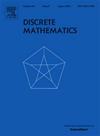排列幂的下降
IF 0.7
3区 数学
Q2 MATHEMATICS
引用次数: 0
摘要
我们考虑一些更一般的问题的特殊情况:π∈Sn有多少个排列π∈Sn有j的下降?在本文中,我们首先用π2的下降数来枚举格拉斯曼排列π。然后,我们考虑所有平方只有一次下降的排列,充分列举下降“小”的情况,并提供一般情况下的下界。最后,我们列举了其平方或立方下降次数最多的排列,并对未来的研究方向进行了展望。本文章由计算机程序翻译,如有差异,请以英文原文为准。
Descents in powers of permutations
We consider a few special cases of the more general question: How many permutations have the property that has j descents for some j? In this paper, we first enumerate Grassmannian permutations π by the number of descents in . We then consider all permutations whose square has exactly one descent, fully enumerating when the descent is “small” and providing a lower bound in the general case. Finally, we enumerate permutations whose square or cube has the maximum number of descents, and finish the paper with a few future directions for study.
求助全文
通过发布文献求助,成功后即可免费获取论文全文。
去求助
来源期刊

Discrete Mathematics
数学-数学
CiteScore
1.50
自引率
12.50%
发文量
424
审稿时长
6 months
期刊介绍:
Discrete Mathematics provides a common forum for significant research in many areas of discrete mathematics and combinatorics. Among the fields covered by Discrete Mathematics are graph and hypergraph theory, enumeration, coding theory, block designs, the combinatorics of partially ordered sets, extremal set theory, matroid theory, algebraic combinatorics, discrete geometry, matrices, and discrete probability theory.
Items in the journal include research articles (Contributions or Notes, depending on length) and survey/expository articles (Perspectives). Efforts are made to process the submission of Notes (short articles) quickly. The Perspectives section features expository articles accessible to a broad audience that cast new light or present unifying points of view on well-known or insufficiently-known topics.
 求助内容:
求助内容: 应助结果提醒方式:
应助结果提醒方式:


